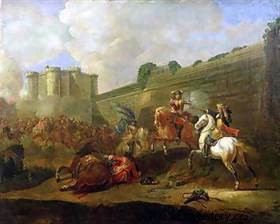 The Fronde , which some have called the beginnings of the French Revolution, is a series of revolts between 1648 and 1653 against the rise of the absolutism of the monarchy in France. Women's revolts because never before have so many women taken part, targeting a woman Anne of Austria; sling of Parliament opposing Mazarin's reforms in the areas of justice and finance; Slingshot of the Princes dissatisfied with Mazarin's hold on the queen. After five years of fierce struggle, the Fronde will stop because of contradictions between the protagonists! But it resulted in extending the power of the minister and restoring absolute royal authority.
The Fronde , which some have called the beginnings of the French Revolution, is a series of revolts between 1648 and 1653 against the rise of the absolutism of the monarchy in France. Women's revolts because never before have so many women taken part, targeting a woman Anne of Austria; sling of Parliament opposing Mazarin's reforms in the areas of justice and finance; Slingshot of the Princes dissatisfied with Mazarin's hold on the queen. After five years of fierce struggle, the Fronde will stop because of contradictions between the protagonists! But it resulted in extending the power of the minister and restoring absolute royal authority.
The Lace Fronde
Originally there are a few pretty ladies who are "evaporated, willful or capricious", excited at the idea of dealing with political affairs. A wind of madness arose and we saw Mme de Longueville, Mme de Chevreuse, Melle de Montpensier and the beautiful Anne de Gonzague, push men such as La Rochefoucauld or Condé to the worst extremities because they were going to pass cheerfully from the camp of the government. to that of the opposition. The parliament stands up against the prime minister by demanding the reduction of the sizes, the protection of the rents and the creation of a chamber of justice to "sovereignly judge the abuses and embezzlements which were made in the finances".
The little dispute could have been settled quickly, but all the ladies and young ladies of the kingdom were soon affected by this madness and Sainte-Beuve reports to us these remarks made by Mazarin to the Prime Minister Spanish, Don Luis de Haro, on the Frenchwomen of the time:“A good woman would not sleep with her husband, nor a coquette with her lover, if they had not spoken to them that day about affairs of State; they want to see everything, know everything, know everything, and, what is worse, do everything and confuse everything. We have three of them, among others, the Duchess of Longueville, the Duchess of Chevreuse, the Princess Palatine, who confuse us every day more than there ever was in Babylon.”
This is how France experienced a succession of revolts between 1648 and 1653, led by very high figures.
The Parliamentary Fronde (1648 to 1650)
The government is made up of the Regent (pending the King's majority) and Minister Mazarin. Princes Gaston d'Orléans, and Condé, the Duchess of Longueville his sister, resented the influence of the Italian and hoped for a place in power. Gondi, future Cardinal de Retz hoped to get the hat.
Mazarin wants to finance the Thirty Years' War by reducing officers' wages, increasing taxes on parliamentarians and then on Parisians to compensate for the shortfall in size in the rest of France. The nobility feels threatened, the parliament and the princes find this unacceptable. In 1648 the Parliament of Paris, the Cour des Aides and the Chambre des Comptes came together to reform the State. The representatives of the 3 organizations then presented to the Queen a program of 27 articles providing, among other things, the abolition of the intendants (those who levied taxes) and the prior agreement of parliament in the event of a new tax.
 Anne of Austria, advised by Mazarin, agrees, but does not sign the document. Dissatisfied with these demands, she had one of the main parliamentarians arrested in August 1648:Pierre Broussel, much appreciated by the people of Paris. This is the beginning of La Fronde. On August 26, the Parisians, 100,000 armed men set up around 2,000 barricades in the streets, stretch chains across them, call themselves “slingers” a name borrowed from children’s play; Mazarin has only one solution:Broussel is released 2 days later.
Anne of Austria, advised by Mazarin, agrees, but does not sign the document. Dissatisfied with these demands, she had one of the main parliamentarians arrested in August 1648:Pierre Broussel, much appreciated by the people of Paris. This is the beginning of La Fronde. On August 26, the Parisians, 100,000 armed men set up around 2,000 barricades in the streets, stretch chains across them, call themselves “slingers” a name borrowed from children’s play; Mazarin has only one solution:Broussel is released 2 days later.
Despite this, the people of Paris continue the revolt. The court fled the capital for Rueil in September 1648, Condé placed himself at the disposal of the royal power and the regent finally signed the document a month later, then returned to Paris. But the parliament continues to rebel:violations are made to the document, Mazarin plans to lay siege to Paris to reduce the city to famine.
Not daring to stay in the capital, the royal family decided to go discreetly to St Germain en Laye in January 1649. It was at this time that Parliament entrusted the troops to the Prince of Conti, brother of Condé. He will be helped by the Duke of Bouillon, Beaufort and Marshal de La Mothe. Gondi participates in the revolt. We see him walking around Paris, on horseback, with pistols in the saddle to excite the people!
The people are not really angry with the mother of the future king, but especially with Mazarin. In the shelter, the regent tries to regain power and Mazarin places the royal troops under the command of Condé around Paris, to besiege it. The king's soldiers ravage the south of Paris, Turenne allies himself with the slingers and will be declared guilty of lèse-majesté. In March 1649, the parliamentarians signed the Peace of Rueil, obtaining some financial arrangements, the troublemakers were forgiven, but the people and the bourgeois were very unhappy:their greatest hope was not achieved:Mazarin remained in power. Libels circulate against Mazarin and the provinces in turn rebel.
The Fronde of Princes (1651-1653)
To calm all these beautiful people, Mazarin neutralizes the Vendômes by marrying one of his nieces to the Duke of Mercœur, and promises the cardinal's hat to Gondi. Some slingers therefore rally to the royal power.
 At the beginning of 1650, the Prince of Condé could no longer support Mazarin's lies and his position as Minister (Condé coveted her !), will rally to the Frondeurs. But he was arrested and imprisoned in Vincennes in January. Gondi plots and arrests the Prince of Conti, brother of Condé, as well as the Duke of Longueville, brother-in-law. This is the beginning of the Fronde des Princes. In the provinces, the supporters of the princes rose up, including the viscount of Turenne. They decide to march on Vincennes, Mazarin has the prisoners transferred to Le Havre. Many regions start a civil war:Burgundy, Normandy, Limousin, Poitou, Aquitaine. The parliament and the former slingers approach the princes, until an agreement is signed between Gaston d'Orléans, the slingers and the princes' supporters to obtain their release and especially the departure of Mazarin.
At the beginning of 1650, the Prince of Condé could no longer support Mazarin's lies and his position as Minister (Condé coveted her !), will rally to the Frondeurs. But he was arrested and imprisoned in Vincennes in January. Gondi plots and arrests the Prince of Conti, brother of Condé, as well as the Duke of Longueville, brother-in-law. This is the beginning of the Fronde des Princes. In the provinces, the supporters of the princes rose up, including the viscount of Turenne. They decide to march on Vincennes, Mazarin has the prisoners transferred to Le Havre. Many regions start a civil war:Burgundy, Normandy, Limousin, Poitou, Aquitaine. The parliament and the former slingers approach the princes, until an agreement is signed between Gaston d'Orléans, the slingers and the princes' supporters to obtain their release and especially the departure of Mazarin.
 In an attempt to calm the people and the princes, the regent pretends that Mazarin is gone, who actually flees to Saint Germain. Anne and the young king want to join him, but the people know about it and invade the Louvre Palace in February 1651, to check that Louis is sleeping well in his bed, on the night of February 9 to 10 (a story that everyone knows good). No longer having a choice, she freed the princes, Mazarin fled to the Rhineland, to the Elector of Cologne. He will continue to govern France thanks to his correspondence with Anne of Austria.
In an attempt to calm the people and the princes, the regent pretends that Mazarin is gone, who actually flees to Saint Germain. Anne and the young king want to join him, but the people know about it and invade the Louvre Palace in February 1651, to check that Louis is sleeping well in his bed, on the night of February 9 to 10 (a story that everyone knows good). No longer having a choice, she freed the princes, Mazarin fled to the Rhineland, to the Elector of Cologne. He will continue to govern France thanks to his correspondence with Anne of Austria.
Turenne and the Duc de Bouillon join the king. Condé is released and has only one idea in mind:to take revenge on the regent. His base being Bordeaux, he formed an army with the help of Spain and marched on Paris. The regent is eagerly awaiting the majority of the king in September for him to reign. The court settled in Poitiers. Paris is handed over to parliament, to Gondi and to Gaston d'Orléans, the disorder is total. The head of Mazarin is put at a price:150,000 pounds tournaments. No longer supporting these revolts and the aggressiveness of princes, Louis XIV will raise an army against the prince, an army entrusted to Turenne. Anne of Austria recalled Mazarin at the beginning of 1652, he joined them in Poitiers.
In April, the armies of Condé and Turenne clashed, but without success. They head separately for the capital, because each of them wants to take over Paris. It was then that the daughter of Gaston d'Orléans la Grande Mademoiselle intervened, joining the rebels, disappointed by Mazarin who did not want to let her marry Louis XIV. In July 1652, she opened the Saint Antoine gate to let Condé pass. The icing on the cake:she fired cannonballs against the royal army, and on the heights of Charenton where Louis XIV and Mazarin were. Condé can then seize Paris. It is complete anarchy, the Parisians who have become favorable to the king because of the famine, overthrow Condé and ask to negotiate with the King. Cardinal Mazarin must leave France and goes to Belgium. Condé leaves Paris for Brussels and enters the service of Spain. Louis XIV can finally enter the capital, in October 1652.
The return of peace
 In February 1653, Mazarin regained his place at court, the regent having recalled him when Paris was under the authority of the King. Mazarin condemns Condé to death, who will be pardoned by the King.
In February 1653, Mazarin regained his place at court, the regent having recalled him when Paris was under the authority of the King. Mazarin condemns Condé to death, who will be pardoned by the King.
The revolt is gradually ending except in Guyenne, in Bordeaux. In August, the royal troops marched on the city and managed to recapture it from the slingers. This episode marks the end of the Fronde.
The Prince of Conti will lay down his arms before the king in July 1653, and will marry a niece of Mazarin in 1654. Gondi, who became a cardinal in September 1651, was thrown into prison at Vincennes . He escaped in 1654 and went to Rome. The Duchess of Longueville will not be disgraced:she withdraws from the world and becomes a great figure in the abbey of Port Royal. La Grande Mademoiselle received an order of exile in October 1652, left for her domain of Saint-Fargeau and began her Memoirs.
From this period dates the monarch's desire to be absolute master, without a minister, without any power in parliament. King Louis XIV will surround himself at Versailles with the greats of the kingdom in order to better monitor them.
Bibliography
- Memoirs of the Grande Mademoiselle by Anne Marie de Montpensier. Mercury of France, 2008.
- Chronicle of the Fronde by Mme de Motteville. Mercury of France, 2007.
- La Fronde by Hubert Méthivier. PUF, 1984.
- History of France, Volume 12:Richelieu and the Fronde by Jules Michelet. 2008.
